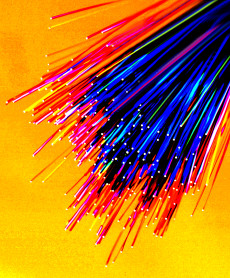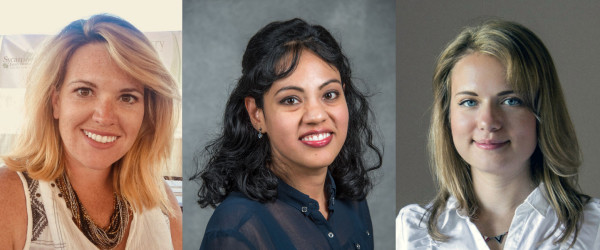AI for More Efficient Flying Qubits
LDRD Project Aims to Up the Efficiency of Converting Optic Signals to Quantum Connections
December 2, 2020
By Jon Bashor
Contact: CSComms@lbl.gov

In order to use existing optical network fibers such as these, qubits (quantum bits) need to be efficiently converted to "flying qubits." (Credit: Berkeley Lab)
As quantum computers evolve from theory to functioning machines and begin solving problems beyond the capabilities of even the fastest supercomputers, finding a way to link these powerful new systems to communicate with other quantum machines becomes the next challenge.
Recently. Mekena Metcalf, Anastasiia Butko, and Mariam Kiran of the Berkeley Lab Computing Sciences Area decided to pool their expertise after attending a workshop in San Francisco aimed at helping women project leadership confidence.
“I'm excited to see this project in quantum networking getting started as a complement to our many successes focused on quantum computing,” said Jonathan Carter, the associate laboratory director for Computing Sciences at Berkeley Lab and co-lead for DOE’s Advanced Quantum Testbed project. “Quantum networking offers a route to building scalable quantum computers, connecting future quantum computers together, and coupling quantum sensors together to improve precision.”
Many CPU-based supercomputers are connected both internally and with similar systems via optical networks, which transmit information as photons. But quantum systems operate at a different energy level which isn't compatible with optical cables. In order to use existing optical cables, the quantum computer’s qubits need to be converted to “flying qubits” which could then “fly” through telecommunications fiber to make quantum connections. This conversion from one form of energy to the other is called transduction, a technology problem identified as one of the most limiting in helping quantum computing go mainstream.
As a result, transduction has been under study for more than ten years, with results showing increasing efficiency. In recent transduction experiments, led by the National Institute of Standards and Technology, researchers were able to achieve 47 percent efficiency and reached a coherent state.

Mekena Metcalf, Mariam Kiran, and Anastasiia Butko are Berkeley Lab researchers using artificial intelligence (AI) techniques to boost the efficiency of a process that makes it possible to connect quantum computers via fiber optic cabling, a key challenge to quantum computing's widespread adoption.
“That's pretty darn good, but I think we can do better with better computational methods,” Metcalf said.
The Berkeley Lab team is developing an approach aimed at attaining the higher quantum state and reaching the quantum threshold limit.
Kiran, a research scientist with the Energy Sciences Network (ESnet) who leads a project using artificial intelligence to improve optical networks, wondered if the same technique could be used with quantum networks. She approached Butko, a research scientist in the Computer Architecture Group who is working at the interface of adapting existing software to quantum hardware. Butko then contacted Metcalf, a postdoc in the Computational Chemistry, Materials & Climate Group who earned her Ph.D. in theoretical quantum physics. Together they wrote a proposal for support under the Laboratory Directed Research and Development (LDRD) program and received funding for “AI-enabled Control for Enhancing Quantum Transduction.”
As the quantum scientist, Metcalf is the principal investigator for the project, making her one of very few postdocs to achieve this role.
“It’s a testament to the quality of their proposal that it will be led by a post-doctoral researcher,” said David Brown, director of the Computational Research Division, in which Metcalf and Butko work. “Mekena is the first postdoc, apart from our Alvarez Fellows, ever to lead an LDRD project.”
But it’s clearly a team effort.
“We are each providing a different perspective that complements the others,” Metcalf said. “This is way cooler than anything I would have been able to do on my own.”
To create transduction, photons are pumped into a cavity and need to be forced to interact strongly with each other, which requires a lot of energy. Dissipation and noise from the environment lower the efficiency, which led the team to propose an adaptive control method to optimize transduction.
Their goal is to develop an adaptive control method for the quantum transduction processes and then test it against a simulator of an optomechanical quantum transducer. So rather than build an expensive prototype and hope it works, the team plans to use high performance computing systems and AI to develop the control method, plus a computer-simulated transducer to run a virtual experiment comparing them.
To train the control method, the team will use a form of AI known as deep reinforcement learning. The AI agent – or “robot,” as Metcalf describes it to non-technical folks – will work without direct supervision as it tries to optimize the environment for more efficient transduction. As it explores possibilities, it will receive a virtual pat on the back when it makes a move that will increase efficiency. If it takes a step that would lessen efficiency, it will stop and try another direction.
Other organizations, such as Google, are also using AI to try to improve quantum computing, Metcalf said. Word of the project is also getting around the lab, and other researchers are asking questions and offering suggestions.
“It's generating a lot of interdisciplinary thinking and getting us out of our silos,” Metcalf said. “It's opening a lot of doors for us.”
The project launched about two months ago, and the team is now working on the modeling software. “It's an interesting challenge in that we need to deal with a multi-physics problem,” Metcalf said. Another challenge is to accurately articulate the problem for the AI agent to solve so that they don't introduce mistakes that the AI will magnify.
“What I'm going to do is build an environment for the agent to operate in as we put it through its paces,” Metcalf said. “That's the really tricky part.”
About Berkeley Lab
Founded in 1931 on the belief that the biggest scientific challenges are best addressed by teams, Lawrence Berkeley National Laboratory and its scientists have been recognized with 16 Nobel Prizes. Today, Berkeley Lab researchers develop sustainable energy and environmental solutions, create useful new materials, advance the frontiers of computing, and probe the mysteries of life, matter, and the universe. Scientists from around the world rely on the Lab’s facilities for their own discovery science. Berkeley Lab is a multiprogram national laboratory, managed by the University of California for the U.S. Department of Energy’s Office of Science.
DOE’s Office of Science is the single largest supporter of basic research in the physical sciences in the United States, and is working to address some of the most pressing challenges of our time. For more information, please visit energy.gov/science.









